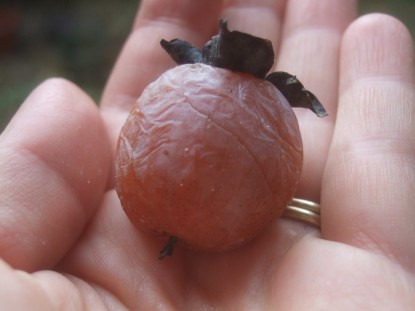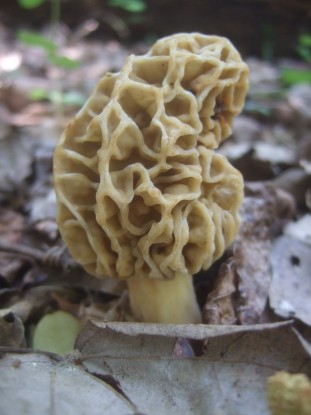
The man answering the door appeared puzzled. I repeated the question.
“The black walnuts in your yard by the street – do you mind if we pick them up?” I waved my arm toward the ground, blanketed with nuts whose husks were Kermit-the-frog green.
“Oh. Um, sure. Go ahead.” He closed his door, still looking a little confused.
It’s the season of plenty for urban and country foragers, those of us who pluck spring’s wild violets for fragrant syrup, snag wintergreen berries from mountain trailsides or make preserves from August’s vacant-lot figs.
Now, all over Carolinas where I live, hickory, pecan and black walnut trees are dropping their nuts. Hundreds of pounds of food lie in sidewalks, roll into gutters, and eventually rot in the rain.
For my family and I, autumn means we check the status of parking lot pecans while we wait for appointments. On the way home from a suburban Target store, we spy a persimmon tree leaning over the sidewalk. We pull over to gather the sweet-soft fruit from the ground and later savor the taste of nostalgia in the form of a persimmon pudding.
What’s the appeal of eating from the landscape? There’s the delight in being more attuned to the subtle seasonal changes. There’s the fun of giving away wild hickory nut biscotti at Christmas or making my mother’s famous black-walnut fudge. But there’s also this: In a time of rising food prices, we are, in a small way, eating for free.
In our town, shelled black walnuts cost about $18 a pound. Devilishly hard to crack, they come by that price honestly. But why buy nuts for oatmeal and baking when they are rolling all over city sidewalks?
To be sure, you’ve got to be willing to husk, cure and crack the nuts. You need to avoid sprayed plants and areas next to heavy traffic and must seek permission before harvesting on private property. But the morel mushrooms my children and I gathered in spring, the dandelion fritters we’ve made from our own front-yard weeds and the vanilla-spiced pears we canned after picking, with permission, from a neighbor’s feral tree all were more than worth the effort.

Foraging awakens our senses to the natural world, filling not just our stomachs – but our souls.
backyardandbeyond blogs at Backyard & Beyond.
Do you have a recipe post or kitchen-related story to share on the Farm Bell blog?
See Farm Bell Blog Submissions for information, the latest blog contributor giveaway, and to submit a post.
Want to subscribe to the Farm Bell blog? Go here.



kellyb says:
Beautifully written post. Around here we can add: blackraspberries, wineberries, blackberries and wild grapes. I just found hickory nuts on a path we hiked recently. It was like finding a treasure.
My mom and dad used to go mushroom hunting as well as gathering paw-paws. Lots to learn and eat.
I look forward to your next post.
On November 9, 2011 at 6:48 am
lattelady says:
Love the pic of the morel. They are sooo good.
On November 9, 2011 at 8:26 am
Kathi N says:
My husband (Jim in Colorado) has done this his entire life. We’ll be driving down the road and he’ll pull over so fast I’ll think he’s about to be sick, only to find out that he saw plums or chokecherries growing in the ditch.
One year he picked a 5-gallon bucket of chokecherries from Red Rocks park. I had just learned how to make jelly.
May I just say that 5-gallons of choke cherries is a LOT?
Thank you for the nice post.
On November 9, 2011 at 8:51 am
marymac says:
I just cleaned up a nice bunch of Black Walnuts, and I loved doing it. We have become such a society of dependent people. We have every thing at our finger tips, just go to the grocery store . This makes me feel good doing something for myself that we can eat for free. Thanks for posting this.
On November 9, 2011 at 10:02 am
Cathy J says:
Wonderful post!
On November 9, 2011 at 10:23 am
lisabetholson says:
This is a great reminder of all the wonderful things we can collect from God’s world if we look. I have a friend who has several trees and she uses none of the fruit. I have found pecans on the backroad and there are 10 chestnut trees here locally. Fruit and nuts are everywhere if we would only look.
This is a GREAT POST. Thank you
On November 9, 2011 at 10:29 am
Courtney says:
We have a hickory nut tree and last winter I diligently gathered up nuts, and left them in a huge wire basket in the breeze way to stir whenever we happened to think about it. They dont have big nutmeats but free is free.
This spring I thought I noticed the level of the nuts getting lower and lower, but decided that it was my imagination. Then we found our theif when we surprised a squirrel that was sitting in the basket selecting another nut to reclaim. I’m pretty sure it was one particular squirrel because this one behaves in a rather un squirrel like manner, he obviously thinks he is a nut eating cat. We spent the next few weeks watching him steal the nuts one at a time. It was so entertaining that it was worth the loss of the nuts.
On November 9, 2011 at 11:41 am
brookdale says:
Courtney, that squirrel probably thought you put the nuts there just for him! Did he eat them or bury them?
Backyardandbeyond, great post! We used to go out in the fields after the potato pickers were done and pick up lots of perfectly good potatoes for winter. And my mother knew where there were wild crabapple trees, we’d pick them every year and she would make jelly.
On November 9, 2011 at 5:45 pm
huntermom says:
Great post. I also love driving around and finding free berries and such. One Sunday after church I stopped by a house and asked if I could have plums that were in her back yard. BEST jelly ever. Made some and took to the lady….I think she was happy, hard to tell when you get someone out of the shower to shower with jelly. Ha 🙂 It just tastes better if it is free.
On November 9, 2011 at 9:04 pm
Joy says:
My mother and grandmother both gathered poke in the spring for poke salad. Some people call this inkberry as the black berries were once used for homemade ink or dye. The berries can be used for juice (good for aches and pains, my grandfather said) or made into jelly but the seeds, roots, and stems are toxic. Various parts of the plant have been used for medicine forever.
And, look around for the fern-like leaves of wild asparagus so you can pick the delicious new shoots in the spring. As you drive you can see the early asparagus with its distinctive ferns and usually find a bunch of stalks hidden in the grass nearby.
On November 10, 2011 at 10:02 am